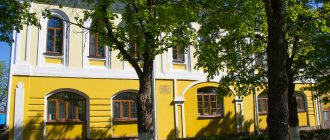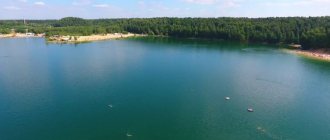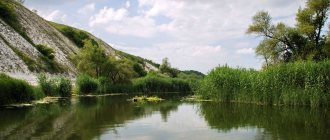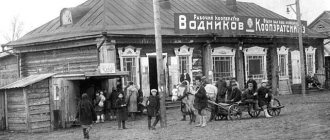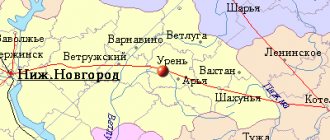Ironworks
Surely many will be interested to know what has become of the ironworks. Today this is the leading enterprise of the city, called Omutninsky Metallurgical Plant CJSC, which produces and deals with everything - the automotive industry, elevator construction, the mining industry, the foundry industry, the agricultural machinery industry, the construction industry, and much more. .
Of course, you can only look at the plant from the outside. It is unlikely that you will be able to get into its territory, and this is not required, since you can visit the factory museum and exhibition center.
Location: Kokovikhin street - 2.
Pedigree of the small homeland
The settlement at the Omutninsky plant arose in 1773. Received city status in 1921. The center of the district of the same name.
It is located in the north-eastern part of the region, at the intersection of the Omutnaya River (a tributary of the Vyatka River) with the Yar-Verkhnekamskaya railway. The distance to the regional center by rail is 232 kilometers, by road - 200 kilometers.
Population - 29.6 thousand people (1993).
The history of the emergence of the city of metallurgists and its development is inextricably linked with the metallurgical plant.
The history of the city goes back to the distant 17th century. At that time, iron was imported into our country from Sweden. But the long-term war with it deprived Russia of this opportunity. There was an urgent need for our own metal, and the state began to promote the development of iron smelting and ironworks in the Urals. Searches for ore were also carried out in Upper Vyatka.
On June 6 (17th New Style), 1773, the State Berg College issued a decree on the construction of an ironworks along the Omutnaya River with one blast furnace, a furnace factory with 6 forges and steam hammers, ordering: “the plant should be completed and put into operation... in a three-year term is irrevocable.” The owner of the Pudem plant, Lieutenant Colonel I.P. Osokin, and he carried out his decree: he built the plant. In the fall of 1755, the first melt was issued.
The prerequisites for the founding of the plant were ore-bearing areas and huge forests that provided charcoal for blast furnace smelting and industrial iron production. And, of course, a river suitable for creating a pond and providing rafting of finished products. Serfs were brought to the deep, almost deserted forests: 22 women and 22 men. Osokin them . Later, another 540 people were resettled - state peasants from the Yugovsky, Kurashimsky, Igrimsky factories.
Housing, a factory, a dam were built in difficult conditions. It is difficult to imagine how much effort was spent on creating just one pond, the surface of which is almost eight hundred hectares.
They manually lifted ore into the blast furnace, poured hot metal, and fed heavy red-hot ingots to flattening mills. For 12 - 14 hours a day they received 30 - 40 kopecks. Those who mined iron ore with a pick and crowbar, collected firewood and charcoal, earned even less.
The work was seasonal. In the spring, during high water, the metal was floated on barges along Omutnaya and Vyatka, since the main market was the Nizhny Novgorod Fair. Then the plant was shut down until September. Some worked in mines, burning coal, collecting firewood, while others worked on their farmsteads.
There were no other enterprises in the remote village, so the entire population was made up of factory workers. True, peasants gradually arrived from neighboring volosts and settled in miserable shacks, dugouts, “chadovkas,” and plank barracks. Only a few residents lived in wooden houses built on the banks of the pond.
The oldest building that has survived in Omutninsk to this day is the house of a serf, taken from the Nizhny Novgorod province by the founder of the plant, Osokin . The owner of this two-story house subsequently worked as one of the first managers. Built from a large pine forest, the house has not been rebuilt for two centuries and is currently a historical and ethnographic monument. The building is now occupied by the editorial office of a regional newspaper.
The owners of the plant rarely came to this wilderness. The managers were their trustees.
The plant developed slowly. The village grew just as slowly. It was called in honor of the owner of the plant, first Osokino, later - Omutnaya, and even later - Omutninsky plant.
After the death of Ivan Petrovich Osokin in 1808, the plant passed to his sons Peter and Gavrila , and in 1848 to the Yaroslavl merchants Pastukhov. By this time, two thousand tons of cast iron and 900 tons of iron were being smelted annually.
The second blast furnace and puddling and welding shop were built in 1861. Later, on the site of the factory, there was a sheet-rolling shop. The population of the village naturally grew, since in conditions of low-productivity manual labor, production growth is unthinkable without increasing the number of workers.
Exhausting work and poor financial conditions were the causes of frequent riots and uprisings. Despite the abolition of serfdom, dependence on the owners remained. There was nothing to pay for the ransom. The murmur of the workers forced the plant management to resort to flogging and exile of the dissatisfied to Siberia.
Not everything went smoothly for the plant owners. The seasonal nature of production affected. There were problems with the delivery of raw materials and fuel. And although the first open-hearth furnace, a rolling shop with mills 500 and 280, and a power plant had already been built, the Pastukhovs in 1913 sold the plant to the joint-stock company of the North Vyatka Mining Plants.
However, by the end of the 19th century, the plant was considered a major enterprise in the country's ferrous metallurgy. And the village of Omutninsky is a large populated area in the Vyatka province. There were one and a half thousand households and three thousand people lived in it.
When Omutninsky district was formed, Omutninsk, which received city status in 1921, became the district center.
At the intersection of the Omutnaya River and the Yar-Lesnaya railway, Omutninsk is located on five thousand hectares in the northeast of the region. Omutnaya is a left tributary of the Vyatka, 56 kilometers long. The pond is the second largest artificial reservoir in the region after Belokholunitsky. The river and pond are sources of industrial water supply.
The terrain is replete with deep ravines. The central part of the city is low-lying, the northern part is elevated, mountainous. The western and southern parts are also elevated. Elevations range from 190 to 220 meters above sea level.
At one of the city celebrations in October 1926, a local poet, known under the pseudonym Burerodny, read a poem about his hometown. Some lines stuck in my mind:
I'm going to Omutnaya again
Deaf and dark town,
Where in the winter at night time
A clumsy bear is wandering,
Where there is almost no entertainment
And where am I the only poet...
Omutninsk looks completely different today - the center of economic and cultural life of the region, the only city of ferrous metallurgy in the region. In social production, industrial workers account for 70 percent.
Metallurgists, as in the past, make up the majority of the townspeople. The plant has grown into a modern enterprise for the production of shaped, hot-rolled, cold-drawn, structural and alloy steels. If at the beginning of the century the plant produced only three profiles of commercial metal, now it produces thousands. The use of high-precision steel shaped profiles increases the metal utilization rate in mechanical engineering, reduces labor costs by almost 70 percent, and increases the reliability of machines. The work on creating these profiles was awarded the State Prize for 1974.
The country's high-rise construction places great demand on elevator guides. Not a single plant in Russia produces as many profile sizes of small-section rolled products in small-tonnage batches as Omutninsky. Almost 600 consumers, including those from near and far abroad, receive products from Omutninsk metallurgists.
Greenhouses, caissons, nails, basins, tanks, watering cans, buckets, kitchen and upholstered furniture, and other consumer goods are in constant demand among the population.
The pride of the plant was the Smirnov, Kuznetsov, Medvedev dynasties. Calibrator N.P. Pavlov is the first of the Omutninsky residents to receive the Order of the Red Banner of Labor in 1931, S.T. Zemtsov is a laureate of the State Prize, distributor A.P. Chirkov is a Hero of Socialist Labor, A.G. Batalov is a candidate of technical sciences , A. S. Ponomareva - Honored Doctor of the RSFSR - almost everyone in the city knows these names.
For the success achieved in increasing metal production, mastering the production of new types of products important for the national economy, and in connection with the 200th anniversary of its founding, the Omutninsky Metallurgical Plant was awarded the Order of the Red Banner of Labor.
Considerable credit for the rebirth of the enterprise belongs to its leaders. They remember, for example, Alexander Leontievich Aleinov with warm words. Having stood at the head of the plant for a quarter of a century, he raised the glory of Omutninsk steel.
Aleksey Maksimovich Petrenko, Honored Metallurgist of the RSFSR, spent his entire working life at the plant He is rightfully awarded the Order of Friendship of Peoples, the Badge of Honor, the Red Banner of Labor, two bronze and a silver medals from VDNKh.
Before the October Revolution of 1917, the metallurgical plant was the only industrial enterprise in the city. In today's Omutninsk there are two dozen of them. During the years of the first five-year plan, the Yar-Fosforitnaya railway line was built. Stalnaya station is one of the main ones on this road in terms of freight turnover. This accelerated the rate of growth of the city.
Many city residents are employed in the timber industry. The main activities of the Omutninsky and Kamensky timber industry enterprises, the Zalazninskles association, and the inter-farm forestry enterprise are the procurement and removal of industrial wood, its primary processing, and cutting into assortments. Here they produce residential buildings, houses for garden plots, frames for loggias, window and door blocks, greenhouses, decorative cladding boards, garden posts, picket fences, and garage doors.
Industrial and cultural construction is carried out by contracting organizations and a construction and installation trust, which is trying steps in large-block housing construction. The dairy plant, meat processing plant and bakery plant are expanding their product range.
Each generation gives the city its own deeds and ideas.
Mining engineer A. A. Siegel , the initiator of raising the pond dam, building the first school and the Orthodox Church of Alexander Nevsky in 1853, left a good memory of himself. His progressive views caused a quarrel with the owner of the plant, which is why Siegel left the service.
The factory museum contains memories of another engineer-academician M.A. Pavlov, the author of textbooks on metallurgy.
And the current generation of Omutninsky residents will undoubtedly leave a mark on themselves, since it is they who make the city beautiful, comfortable, and comfortable. Residents and guests have access to a railway station, a market, numerous workshops, shops, cafes, a Palace of Culture, a Spartak cinema, a music and art school, and several libraries. Branded stores of processing enterprises and new bus routes have been opened. The number of individual housing developers is growing. The Youth Labor and Leisure Exchange creates jobs for young men and women. Eleven gardening and two livestock partnerships have been formed.
If at the beginning of the 20th century there were only a five-year zemstvo school and a women's gymnasium and not a single preschool institution, now there are 17 kindergartens and nurseries, a specialized speech therapy center, seven secondary schools, an interschool plant, two secondary specialized educational institutions, a vocational school, and a children's home. creativity and youth with two branches, House of Technical Creativity, Sunday school of the Orthodox community.
The pedagogical school trains primary school teachers and kindergarten teachers. The medical school has three departments: paramedics, midwives and nurses. SPTU-20 produces specialists for the construction trust.
Instead of one doctor and a hospital with 15 beds, as was before, now Omutninsk residents are served by half a thousand doctors, nurses, and nannies. The buildings of the district central hospital and the metallurgical medical unit, dental and children's clinics were rebuilt. The sanatorium-preventorium “Metallurg” is available to workers. The department of social protection of the population has opened a day care center for those in dire need of hot meals and medical care.
Workers from communications, the internal affairs department, the court, the prosecutor's office, the bar, banks, the sanitary and epidemiological station, and the television workshop moved into the new buildings. New multi-storey residential buildings and industrial facilities are being built. Cable television has become a fixture in the lives of Omutninsk residents. The day is not far when natural gas will come to the apartments of citizens, and oil production will provide additional fuel and lubricants for local enterprises and organizations.
Among the initiators of many undertakings are an honorary citizen of the city: doctor A. A. Gorbunova, mason V. K. Medvedev, teacher A. I. Prozorova, master pastry chef G. P. Shumailova.
Any place for recreation for city residents - an amusement park, halls with computer games and video installations, a stadium, the Stroitel sports complex, two ski resorts, an illuminated ski track and roller skating slopes, three country children's camps. The water station brings together children and adults for city celebrations, rowing and swimming competitions. Here you can sunbathe, rent a boat, catamaran, or pedal boat.
On the factory square there is a monument to metallurgists who died during the Great Patriotic War. 1,178 factory workers fought on its fronts, and only 275 returned alive. The title of Hero of the Soviet Union was awarded to A. E. Medvedev, P. E. Russkikh, N. I. Ryaposov. In the city cemetery there is the grave of the Unknown Soldier. With pain in their hearts, the townspeople bow their heads in front of the obelisks, remembering the price of victory. In total, 15 thousand Omutninsk residents visited the battlefields.
Passionate people live in this northern region: hunters and fishermen, beekeepers and tourists, athletes and musicians, poets and artists...
The Russian song choir, the puppet theater, the theater studio “Diletant”, which received the title of folk, as well as the children’s theater-studio “That’s right”, the theater “Poisk”, the ensemble “Ayushka”, and the studio of pop miniatures were loved by many.
The brass band under the direction of metallurgist Georgy Larin celebrated its fiftieth anniversary. And how enthusiastically the audience received the children’s ensemble “Lapotok”. Its creator, Anatoly Slanchev , is a great connoisseur of Russian folk songs. , A.I. Raga has been teaching children clay modeling in a Dymkovo toy circle Alexei Rodygin, fascinate with their originality and color . The prose writer and playwright L. A. Kozhevnikov comes from Omutninsk.
The city is rich in sports traditions. Skiers and sambo wrestlers, volleyball players and football players, ship and aircraft modellers defend his honor at competitions at various levels.
Pupils of the children's and youth sports school are regular winners of regional competitions. The Youth Sports School was founded by S. A. Gerasimov. From its walls, under the leadership of the Honored Trainer of the RSFSR G.I. Babailov and the Honored Worker of Physical Culture and Sports of the RSFSR E.A. Porubov, 35 masters of sports in cross-country skiing emerged. These are the champion of the 1972 Olympic Games in Sapporo (Japan) Yuri Skobov, international master of sports in biathlon Vladimir Dokuchaev, Russian champion Vladislav Zapolskikh and others.
Aircraft of his own design are made by steelmaker V. S. Saulov. And he makes flights over the city on them. Not everyone will understand his eccentricity. The first aircraft was built in his own two-room apartment on the fourth floor, from the window of which the aircraft was unloaded on ropes before testing. He acquired the unique feeling of flight from his fellow countryman V.A. Trapeznikov, who twenty years ago surprised the townspeople with his flight to Omutninsk from the village of Zalazny.
There are now four aircraft in the city. Among Saulov’s are turner A. A. Gorev, mechanic I. A. Gushchin, blacksmith S. V. Devyaterikov, roller V. B. Koshcheev. They design themselves, they fly themselves. A homemade trike also rose above the city. Fanatically in love with the sky , G. A. Ilyin, its creator, leads the hang gliding section in the technical creativity club.
An exhibition of drawings and photographs about Omutninsk was recently held with great success in the center of culture and art of the American city of Delaware. The chairman of the International Friendship Committee, foreign language teacher E. A. Kozhevnikov established contacts with America .
More than once on television, residents of the region were introduced to the excellent hunter M.F. Turuntsev, who has several dozen wolves alone. Unique elk antlers, skins of lynxes, bears, wolves, obtained by L. S. Nelyubin, visited international exhibitions in Munich, Plovdiv, VDNKh in Moscow.
Omutninsk is looking to the future. The city's master plan provides for multi-storey construction in the center with three microdistricts. More multi-storey residential buildings will appear in the north-eastern part. The appearance of the city will change for the better. The main prospect for its renovation is growth upward, replacing old wooden buildings with new blocks. As construction progresses, new shops, canteens, and welfare service workshops will open. City communications will be further developed. Recreation areas will be improved - the left side of Svoboda Street from the embankment, the park on the hills, the shore of the pond to Peschanka Bay.
The city is being reborn and confidently steps into tomorrow.
Key dates
1773 - founding of an ironworks on the Omutnaya River.
1775 - the first melt was produced.
1853 - the Alexander Nevsky Temple was built.
1861 - a second blast furnace and a puddling and welding shop were built.
1913 - the plant is transferred from private ownership to the joint-stock company of the North Vyatka Mining Plants.
1921 - Omutninsk receives city status.
1929 - Omutninsky timber industry enterprise was created.
1930 - a pedagogical school was opened, the first issue of the newspaper “Voice of the Worker” was published.
1931 - the first steam locomotive arrived at the Stalnaya station.
1935 - a medical school opened.
1972 - Yuri Skobov won the gold medal in the 4 x 10 km ski relay at the 11th Winter Olympic Games in Sapporo (Japan).
1991 March 24 - the church in the name of the Intercession of the Most Holy Theotokos of the Old Believer community, built with donations from parishioners, was consecrated.
About the workers' village Vostochny
It is necessary to say a few more words about the Vostochny workers' settlement, which arose in 1968 along with the launch of the Omutninsky Chemical Plant (since 1992 - JSC Vostok).
Vostochny is one of the youngest and most comfortable villages in the region. Its entire short history is connected with the Omutninsky chemical plant. At first, temporary barracks and panel houses were erected here. Residents did not have basic cultural and everyday amenities: a bathhouse, a dining room, shops, and a nursery were located in temporarily adapted premises, children studied in neighboring villages, and for medical help they had to go to the regional center 15 kilometers away.
Only after the commissioning of the first stage of the plant in December 1968, the systematic development of the village began according to the master plan. Construction work was carried out by SMU-18. The plant staff and village residents provided great practical assistance to the builders. They can rightfully say that the village was built with their hands, since not a single construction project was completed without their active participation. During the cleanup and resurrection days, the population built a heating main, a stadium, paved the streets, and planted landscaping in the village. By the mid-80s, the barracks and all dilapidated housing were demolished. Now there is not a single unfurnished apartment in the village.
Almost 3,000 people work at the Omutninsky Chemical Plant. Despite the name, there are no chemical production facilities here. The plant specializes in the production of microbiological synthesis products. And it owes its name to its affiliation with the Ministry of Chemical and Oil Refining Industry. The fact is that in the years when the plant was being built, the microbiological industry had just emerged in our country, it did not have its own governing bodies, and it was subordinated to chemists.
Initially, Vostochny produced drugs used as additives to livestock feed, an anti-influenza vaccine and much more. Potato starch, corn flour, and eggs were used as raw materials, which served as a breeding ground for microorganisms, which form the basis of production.
Difficulties associated with the country's transition to a market economy also affected Omutninsk microbiologists. The main production was curtailed. But the plant managed to rebuild. The production of new products that are in high demand has been established: disposable medical syringes, biologically active additives for baby food, whey sugar syrup, a malt substitute for a distillery, the production of artificially grown ginseng biomass for the medical and perfume industries has been expanded, and much more. And in the future - the development of joint projects with American and South Korean companies.
Since 1968, the permanent director of the plant has been Hero of Socialist Labor Vladimir Arkadyevich Valov, a very energetic and enterprising man who enjoys great authority.
From the very beginning of the village's existence, residents took care of its improvement and landscaping. In the neighborhood of the village, a recreation area was equipped, clearings were cut, an artificial pond was created, which became a favorite vacation spot for the village residents, where you can not only swim, but also fish.
The Palace of Culture has also become a favorite vacation spot for residents of the Vostochny village. It employs 19 amateur art groups. Despite all the difficulties and troubles that have befallen the culture, the folk song ensemble “Vesely Uley”, the folk theater group “I am”, the dance groups “Mosaic”, “Sovremennik” and others continue to delight.
There are many sports facilities in the village: two hockey rinks with an electronic scoreboard, a ski lodge with an illuminated track, a shooting range, the Olympus sports complex with sambo, weightlifting, skiing, and hockey sections. In 1984, using the public construction method, the construction of a stadium with a football field and cinder tracks was completed.
Children in the village are surrounded by attention and care. There are four preschool institutions and two secondary schools here. A children's music school was opened in 1970, and a children's art school has been operating since 1976. In 1993, a children's health camp "Volna" was opened on the shore of the pond.
The village lives and develops together with the plant. Its residents associate certain hopes for the future with the discovery of Omutninsk oil.
(V. A. Sitnikov, N. I. Perminova and others “Encyclopedia of the Vyatka Land” Vol. 1. Cities. Kirov. 1994.).
The city of Omutninsk, the center of the Peschansky rural district.
Located at the Stalnaya railway station.
For many years, there were almost no settlements on the territory of the Omutninskaya factory dacha, with the exception of the village of Shuminskaya (Desenyata), which was founded in 1773. After the abolition of serfdom, 10 factory workers wished to engage in agriculture, receiving plots on the territory of the dacha, which became known as the Omutninskaya volost. At the beginning of the 20th century, many built houses on their plots; repairs arose, which were eliminated in the 30s. The collective farms Zlobinsky, Peshchanka, “New Way” and others that arose in their places were created by special settlers from the Falensky region and Udmurtia.
(Encyclopedia of the Vyatka Land, Volume 1, Book 2, Villages, Villages. 2002).
Factory Museum and Exhibition Center
It is located in the local Palace of Culture and opened in 1973. This event was timed to coincide with the bicentenary of the plant. The museum's collection includes both an ethnographic exhibition, that is, ancient household items, models and photographs that tell the history of both enterprises and cities. So are stands with samples of modern steel products produced by the plant. In addition, various exhibitions of paintings, photographs and crafts are constantly held here.
Location: 30th Anniversary of Victory Street - 16.
Population
| Population | ||||||
| 1926[3] | 1931[3] | 1939[3] | 1959[4] | 1967[3] | 1970[5] | 1979[6] |
| 6400 | ↗7300 | ↗17 400 | ↗24 789 | ↗27 000 | ↗28 777 | ↘28 497 |
| 1989[7] | 1992[3] | 1996[3] | 1998[3] | 2001[3] | 2002[8] | 2003[3] |
| ↗29 248 | ↗29 600 | ↘29 200 | ↘29 000 | ↘28 900 | ↘26 065 | ↗26 100 |
| 2005[3] | 2006[3] | 2007[3] | 2008[9] | 2009[10] | 2010[11] | 2011[3] |
| ↘25 400 | ↘25 100 | ↘25 000 | ↘24 800 | ↘24 543 | ↘23 615 | ↘23 600 |
| 2012[12] | 2013[13] | 2014[14] | 2015[15] | 2016[1] | ||
| ↘23 195 | ↘22 892 | ↘22 722 | ↘22 530 | ↘22 442 | ||
Embankment of Omutninsky Lake
After getting acquainted with the history of Omutninsk, it would be good to go to the most beautiful place in the whole city - this is the embankment of Omutninsky Lake. It's actually a pond. But it is so beautiful that both locals and visitors call it a lake.
A walk along the embankment promises to be memorable thanks to the beautiful views all around. In addition, there are benches, a stage, a lighthouse and a monument to a worker with a hammer and sickle.
Location: 30th Anniversary of Victory Street - 16.
Notes
- ↑ 12
www.gks.ru/free_doc/doc_2016/bul_dr/mun_obr2016.rar Population of the Russian Federation by municipalities as of January 1, 2016 - [www.kirovold.ru/content.php?page=xjwbupyn_rus&id=7 Vyatka Old Believers]
- ↑ 12345678910111213
www.MojGorod.ru/kirovsk_obl/omutninsk/index.html People's encyclopedia “My City”. Omutninsk - [demoscope.ru/weekly/ssp/rus59_reg2.php All-Union Population Census of 1959. The size of the urban population of the RSFSR, its territorial units, urban settlements and urban areas by gender] (Russian). Demoscope Weekly. Retrieved September 25, 2013. [www.webcitation.org/6GDOghWC9 Archived from the original on April 28, 2013].
- [demoscope.ru/weekly/ssp/rus70_reg2.php All-Union Population Census of 1970 The size of the urban population of the RSFSR, its territorial units, urban settlements and urban areas by gender.] (Russian). Demoscope Weekly. Retrieved September 25, 2013. [www.webcitation.org/6GDOiMstp Archived from the original on April 28, 2013].
- [demoscope.ru/weekly/ssp/rus79_reg2.php All-Union Population Census of 1979 The size of the urban population of the RSFSR, its territorial units, urban settlements and urban areas by gender.] (Russian). Demoscope Weekly. Retrieved September 25, 2013. [www.webcitation.org/6GDOjhZ5L Archived from the original on April 28, 2013].
- [demoscope.ru/weekly/ssp/rus89_reg2.php All-Union Population Census of 1989. Urban population]. [www.webcitation.org/617x0o0Pa Archived from the original on August 22, 2011].
- [www.perepis2002.ru/ct/doc/1_TOM_01_04.xls All-Russian Population Census 2002. Volume. 1, table 4. Population of Russia, federal districts, constituent entities of the Russian Federation, districts, urban settlements, rural settlements - regional centers and rural settlements with a population of 3 thousand or more]. [www.webcitation.org/65AdCU0q3 Archived from the original on February 3, 2012].
- [www.gks.ru/bgd/regl/B08_14t/IssWWW.exe/Stg/p/08.htm Cities of the Kirov region (number of inhabitants - estimate as of January 1, 2008, thousand people)]. Retrieved June 12, 2016. [www.webcitation.org/6iDNsy0V3 Archived from the original on June 12, 2016].
- [www.gks.ru/bgd/regl/B09_109/IssWWW.exe/Stg/d01/tabl-21-09.xls Number of permanent population of the Russian Federation by cities, urban-type settlements and districts as of January 1, 2009]. Retrieved January 2, 2014. [www.webcitation.org/6MJmu0z1u Archived from the original on January 2, 2014].
- [www.gks.ru/free_doc/new_site/perepis2010/croc/Documents/Vol1/pub-01-11.xlsx Population Census 2010. Population of Russia, federal districts, constituent entities of the Russian Federation, city districts, municipal districts, urban and rural settlements] (Russian). Federal State Statistics Service. Retrieved January 22, 2013. [www.webcitation.org/6GDBk0rPa Archived from the original on April 28, 2013].
- [www.gks.ru/free_doc/doc_2012/bul_dr/mun_obr2012.rar Population of the Russian Federation by municipalities. Table 35. Estimated resident population as of January 1, 2012]. Retrieved May 31, 2014. [www.webcitation.org/6PyOWbdMc Archived from the original on May 31, 2014].
- [www.gks.ru/free_doc/doc_2013/bul_dr/mun_obr2013.rar Population of the Russian Federation by municipalities as of January 1, 2013. - M.: Federal State Statistics Service Rosstat, 2013. - 528 p. (Table 33. Population of urban districts, municipal districts, urban and rural settlements, urban settlements, rural settlements)]. Retrieved November 16, 2013. [www.webcitation.org/6LAdCWSxH Archived from the original on November 16, 2013].
- [www.gks.ru/free_doc/doc_2014/bul_dr/mun_obr2014.rar Table 33. Population of the Russian Federation by municipalities as of January 1, 2014]. Retrieved August 2, 2014. [www.webcitation.org/6RWqP50QK Archived from the original on August 2, 2014].
- [www.gks.ru/free_doc/doc_2015/bul_dr/mun_obr2015.rar Population of the Russian Federation by municipalities as of January 1, 2015]. Retrieved August 6, 2015. [www.webcitation.org/6aaNzOlFO Archived from the original on August 6, 2015].
Stele “I love Omutninsk”
But not everything is so sad in Omutninsk; more positive events are also taking place. For example, quite recently, as a gift for the 245th anniversary, which will come in 2022, at the instigation of the administration, a stele “I love Omutninsk” was installed in the city. It is located at the intersection of streets, so it is clearly visible from all sides.
Other monuments
If you wander around Omutninsk you can see other monuments. For example, to Veterans of combat in Afghanistan and local wars, installed in 2011 on Svoboda Street.
Or a monument to the liquidators of the accident at the Chernobyl nuclear power plant and other nuclear facilities. Its opening coincides with the 25th anniversary of the accident and also falls in 2011. And this memorial is located near the Central Library named after A.L. Aleyny on Vorovsky Street.
And that’s not all, there are other monuments. They are scattered throughout the city.
Famous people
- Skobov, Yuri Georgievich - champion of the XI Olympic Games in the 4x10 km cross-country skiing relay in 1972 in Sapporo, silver medalist of the 1974 World Championships in the relay, repeated champion of the USSR (1972-1974)
- Chadaev, Yakov Ermolaevich - Soviet statesman, economist, Doctor of Economics (1972).
- Testoyedov Nikolay Alekseevich - General Designer and General Director of the Open Joint Stock Company "Information Satellite Systems" named after Academician M. F. Reshetnev", Corresponding Member of the Russian Academy of Sciences

